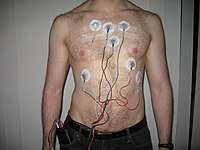
Photo from wikipedia
BACKGROUND The purposes of this study were to create a new flow-chart of prehospital electrocardiography (ECG)-transmission, evaluate its predictive ability for ST-elevation myocardial infarction (STEMI) and shorten door-to-balloon time (DTBT).… Click to show full abstract
BACKGROUND The purposes of this study were to create a new flow-chart of prehospital electrocardiography (ECG)-transmission, evaluate its predictive ability for ST-elevation myocardial infarction (STEMI) and shorten door-to-balloon time (DTBT). METHOD AND RESULTS The new transmission flow-chart was created using symptoms from previous medical records of STEMI patients. A total of 4090 consecutive patients transferred emergently to our hospital were divided into two groups: those in ambulances with an ECG-transmission device with the new flow-chart (ECGT-FC) and those transferred without an ECG-transmission device (non-ECGT) groups. A STEMI group comprising walk-in patients during the same period was used as a control group. The predictive ability of STEMI and the effectiveness of shortening the DTBT by the new flow-chart of ECG-transmission was evaluated. In the ECGT-FC group, the prevalence of STEMI in the ECG-transmission by the new flow-chart were significantly higher than in the non-ECG-transmission patients (6.71% vs. 0.19%; p<0.001). The sensitivity and specificity of the new ECG-transmission flow-chart were 83.3% and 88.1%, respectively. The median DTBT was significantly shortened (p=0.045) and the prevalence of DTBT<90min was significantly higher in the ECGT-FC group (p=0.018) than the other groups. CONCLUSION The sensitivity and specificity of the new flow-chart for ECG-transmission were high. The new flow-chart combined with an ECG-transmission device could detect STEMI efficiently and shorten DTBT.
Journal Title: Journal of cardiology
Year Published: 2018
Link to full text (if available)
Share on Social Media: Sign Up to like & get
recommendations!